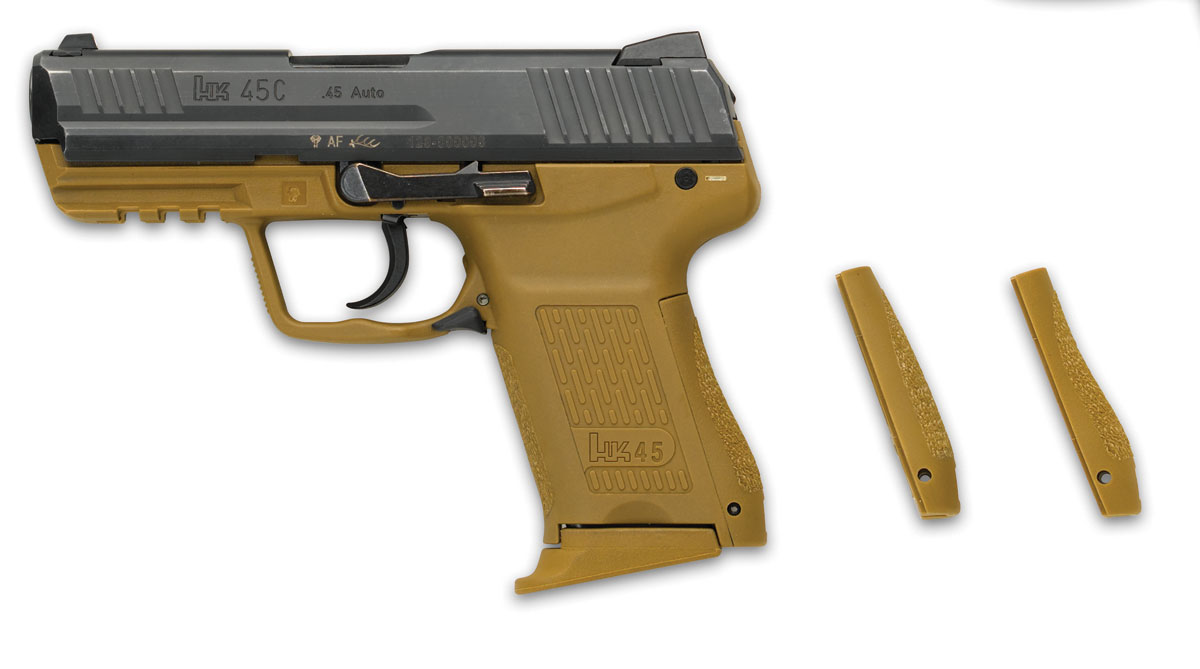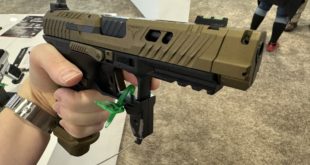By David Crane
defrev at gmail.com
If you’ve been thinking about acquiring a production high-capacity/double-stack polymer-framed .45 ACP tactical pistol, now might just be the right time, considering that you’ve never had more choices. Here’s DefenseReview’s list to look at: Glock 21 (G21) series (including the new Glock 21SF a.k.a. Glock 21 SF) and Glock 30 (G30), Springfield Armory Xtreme Duty (XD) 45 ACP (Standard and Compact models), Smith & Wesson M&P45, and HK45 and HK45 Compact (HK45C).
While we haven’t run any of the above guns under adverse conditions (dirt, mud, sand, water, snow, ice, etc.) and high round count, that’s the list we’d look at initially if we were going to purchase such a weapon, ourselves. One of the guns we’ve heard a lot of good things about from our professional contacts, in particular, is the…

Springfield XD45 ACP .45 ACP pistol. According to several of our contacts, the weapon is reliable and can fire the extreme-high-velocity Le Mas BMT APLP 85gr .45 CQB round, which has enhanced penetration capability and devastating terminal ballistics against live tissue.
While LeMas ammo is somewhat controversial with regard to its metallurgy, bullet construction, and performance in 10% ballistic gelatin, the ammo’s extreme terminal effect on live tissue is, to date, undisputed, to our knowledge. To a man, everyone that’s been present (including a credentialed trauma surgeon and both active and retired Special Operations Forces operators/assaulters and instructors) for live animal testing and steel plate penetration tests, has been impressed with the Le Mas ammo’s performance in various calibers, including 5.56x45mm NATO/.223 Rem., .45 ACP, and 9mm Parabellum.
Stan Bulmer of Le Mas Ltd is impressed with the Springield XD-45ACP .45 ACP pistol, and told Defense Review awhile back that that weapon can safely handle the LeMas BMT APLP 85gr .45 CQB round out of the box. However, if you want to fire that round out of a Glock 21-series pistol (including the Glock 21SF), it’s our understanding that Mr. Bulmer/Le Mas recommends replacing the factory barrel with a KKM Precision barrel, which fully supports the chamber (unverified/unconfirmed). A barrel with a fully-supported chamber, like the KKM barrel, is important for one’s health and well-being when firing the Le Mas BMT APLP 85-grain .45 CQB round out of a Glock 21. The Glock 21’s factory barrel’s chamber simply isn’t supported enough. We’ll try to get confirmation verification on the KKM Precision barrel/Glock 21 issue, and modify this article accordingly.
The Springfield XD-45 ACP .45 ACP compact pistol looks like a good way to go for carry/CCW, provided it’s as reliable and durable as the standard model.
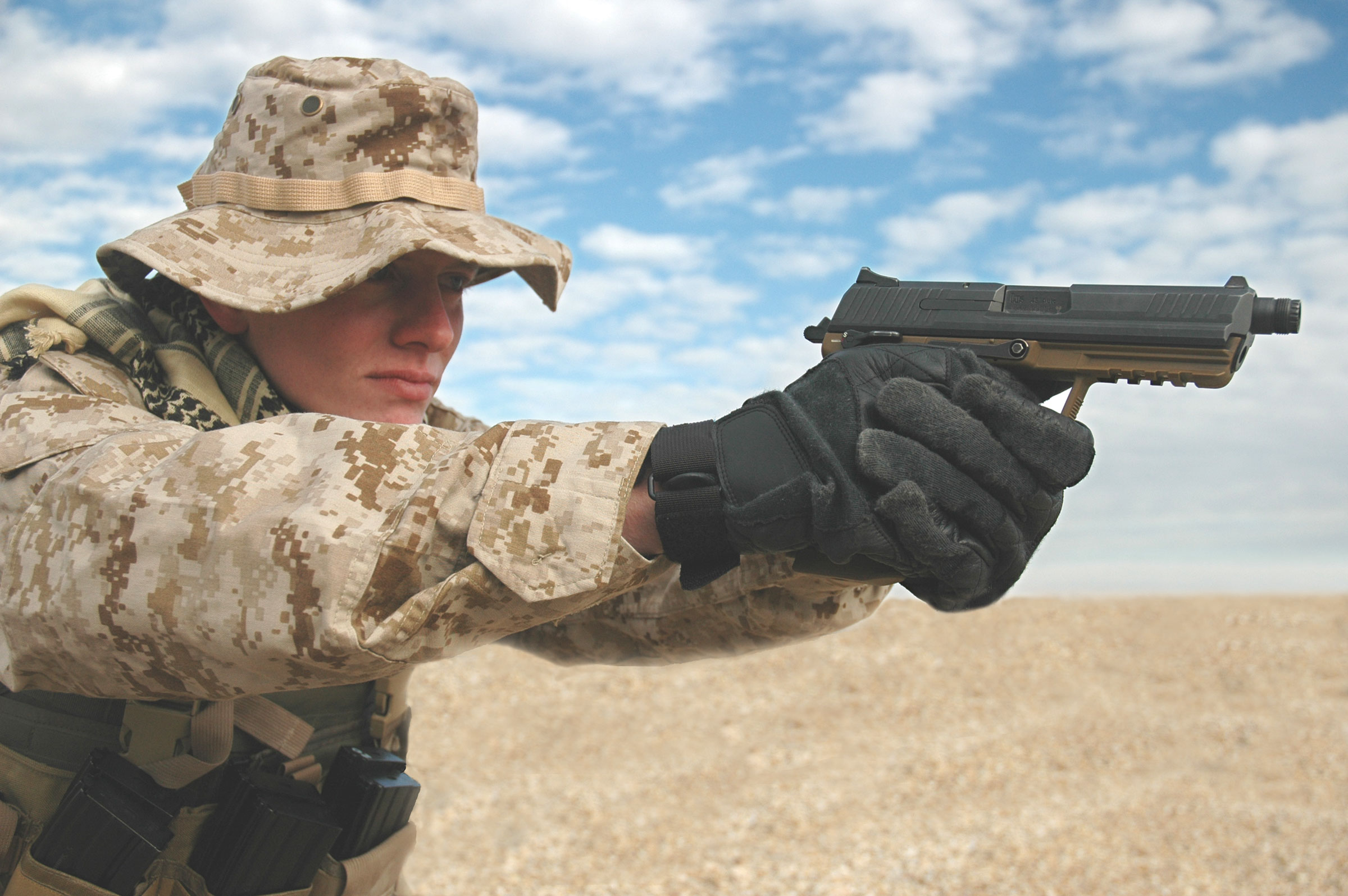
If you’d like to learn more about the HK45 and HK45C (HK45 Compact) .45 ACP pistols, we’d recommend that you read David Fortier’s article on them for Shotgun News, which is provided on Larry Vicker’s website.
Mr. Vickers owns and operates Vickers Tactical, and had a hand in the development of the HK45-series pistols, along with Ken Hackathorn.
DefenseReview would actually like to run the HK45 and HK45C pistols through the ringer at the range with sand, dirt, mud, water—the whole deal. In the meantime, we’ll try to beat the bushes a little bit to find out if the either weapon (HK45 or HK45C) has gone operational with anyone, yet.
In a previous article, we discussed our very limited range experience with the Glock 21 SF .45 ACP pistol. However, it’s a Glock, and in our experience, Glocks work. Assuming we want to shoot LeMas ammo through it and therefore outfit it with a KKM Precision barrel, we’re curious as to whether or not there is any reliability or durability disadvantage with that barrel vs. the Glock factory barrel. If anyone has any information on this, we’d ask that you email us about it.
Last up is the S&W M&P45 pistol, which impressed us at NDIA. Due to time limitations, we were only able to put a few mags through the weapon. However, if the weapon proves reliable and durable under high-round-count and adverse conditions, Smith and Wesson has a winner on their hands. The M&P 45 pistol feels good in the hand, and it’s obvious when you handle and shoot it that a lot of time and effort went into designing and developing the pistol’s ergonomics. The grip is really comfortable. We also like the fact that it’s striker-fired, as opposed to hammer-fired like the HK45 series pistols. The striker allows for a lower bore axis than a hammer, and a lower bore axis is always preferable in a pistol. Defense Review prefers the version with the 1911-style frame-mounted, sweep-down manual thumb safety. This type of safety is fast and intuitive to use (i.e. disengage) once you’ve trained with it and gotten used to it, and can potentially save your life if someone ever grabs your gun in a tussle/streetfight. However, S&W also offers a more Glock / XD-like version of the M&P 45 without a manual thumb safety.
The only feature that really rubs us the wrong way on the Smith & Wesson M&P45 pistol is the internal take-down lever that must be rotated down 90 degrees before the pistol can be field stripped. First, you need to lock the slide to the rear. Then, you need to use a tool like the pin from the base of the frame, a knife, a small screwdriver, etc., or your finger, if you can get it in there far enough, as you have to go through the ejection port to perform the procedure. We opted for the frame /backstrap pin when we did it. Smith & Wesson apparently designed this lever/takedown procedure into the gun for safety reasons, but it’s not good, in our opinion, particularly for military applications. Defense Review likes no-tool field-stripping/takedown. It’s faster, easier, and you don’t have to worry about losing or locating a tool to perform the operation. The internal takedown lever also adds complexity to the design, and is just one more thing that can go wrong, i.e. get damaged and tie up the gun.
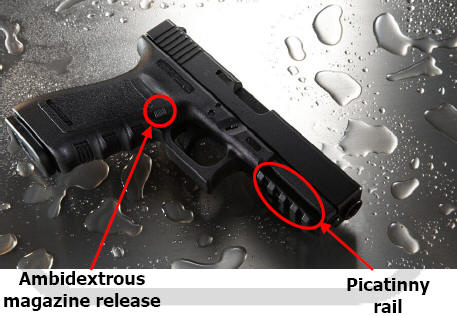
In fact, DefenseReview wishes that Heckler & Koch (HK) had designed the HK45 pistols to be striker-fired, instead of hammer-fired. It’s our understanding that they went with the hammer approach since the basis for the HK45 is the HK USP45 pistol (and perhaps the HK P3000 pistol). They seem to simply have decided to go the safe and easy route on this one. H&K obviously knows how to design and develop striker-fired pistols, since their P7-series pistols are absolute masterpieces of semi-auto pistol design.
I should perhaps note that my first carry gun was an HK P7M13 high-capacity (13 rnds) 9mm pistol (although I now carry a Glock 19). The P7M13’s only drawbacks were its loaded weight and tendency to heat up quickly when firing it at the range. Other than those two things, the gun was fantastic (fantastic and elegant, really), primarily because of its extremely low bore axis, which led to enhanced shootability, accuracy, and “death and taxes” reliability (most important, of course). That gun simply went bang every time with quality factory jacketed ammunition. No lead allowed in this weapon, due to its delayed gas-blowback design.
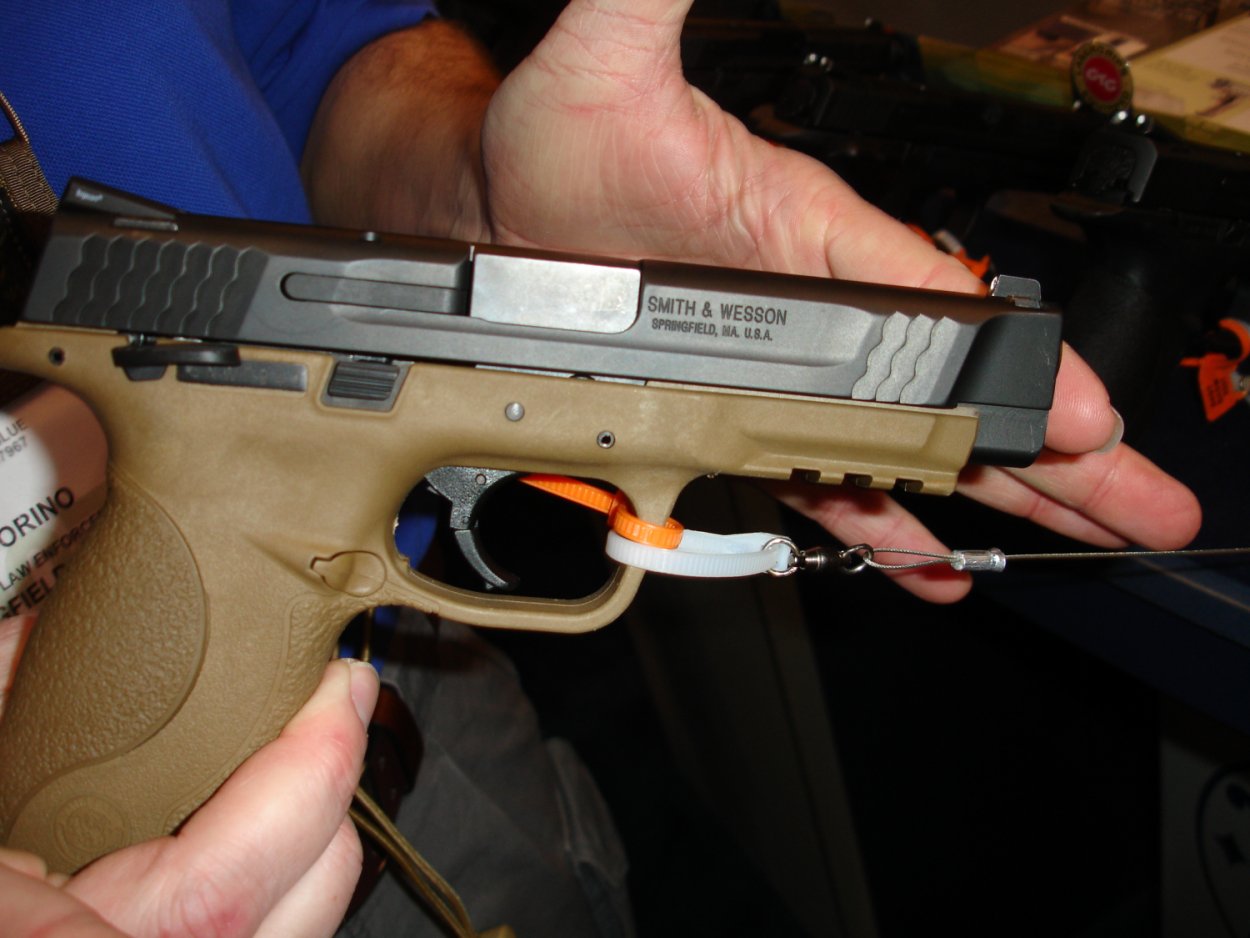
The single coolest feature in the HK P7-series pistols, other than the squeeze-cocker manual grip safety in the front of the grip, is the ability of the operator to remove and replace the entire striker/firing pin assembly in seconds. The whole assembly comes out as a one-piece unit and can be carried around in your pocket until you’re ready to put it back in the weapon. Once that one-piece firing pin/striker assembly is removed from the pistol, it’s impossible to fire it, which makes for a fast method of safe storage if a safe or other locked storage device isn’t available on short notice. DefenseReview of course does not recommend storing a P7-series pistol this way. We only mention it for information purposes.
In DefenseReview’s opinion, a striker-fired HK45 pistol would have been optimal, provided that the striker/firing pin could hit with enough weight to detonate the primers of all 9mm NATO ammunition, without causing too heavy a trigger pull. We have no reason to think that HK couldn’t accomplish this feat in a Browning linkless tilt-barrel pistol, since other manufacturers like Glock, Springfield Armory, and now Smith & Wesson already have (although Springfield licensed the XD / HS2000 pistol design from a Croation company called I.M. Metal). Smith and Wesson’s choice to go the striker-fired route for their M&P pistol line was, in our opinion, a wise move. Nice low bore axis.
And, getting back to the S&W M&P45 pistol, we plan on interviewing Smith & Wesson’s Director of Military Sales, Ernest Langdon, and S&W’s Handgun Product Manager, Joe Bergeron, about the pistol, soon. When we do that, we’ll ask them about the rumored M&P45 Compact pistol.
So, that’s our round-up of our choice in hi-cap "tactical plastic" a.k.a. "tactical tupperware" .45 ACP pistols, but we recommend that you research them for yourself. Looks like a good time to go polymer in .45 ACP.
 DefenseReview.com (DR): An online tactical technology and military defense technology magazine with particular focus on the latest and greatest tactical firearms news (tactical gun news), tactical gear news and tactical shooting news.
DefenseReview.com (DR): An online tactical technology and military defense technology magazine with particular focus on the latest and greatest tactical firearms news (tactical gun news), tactical gear news and tactical shooting news.


